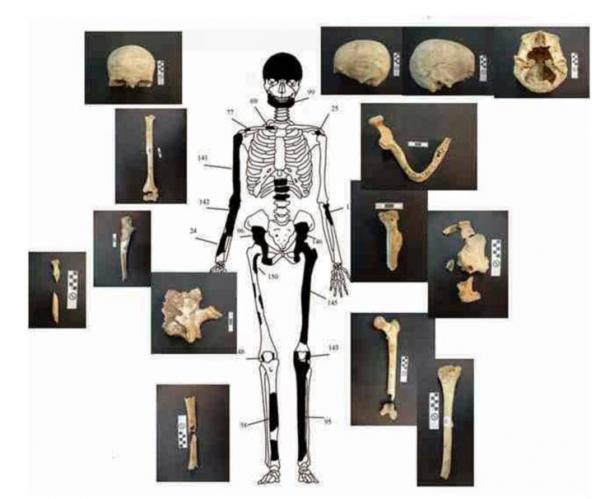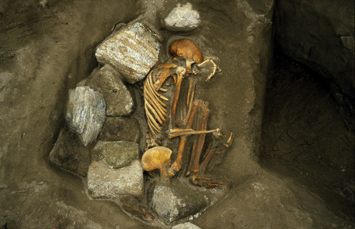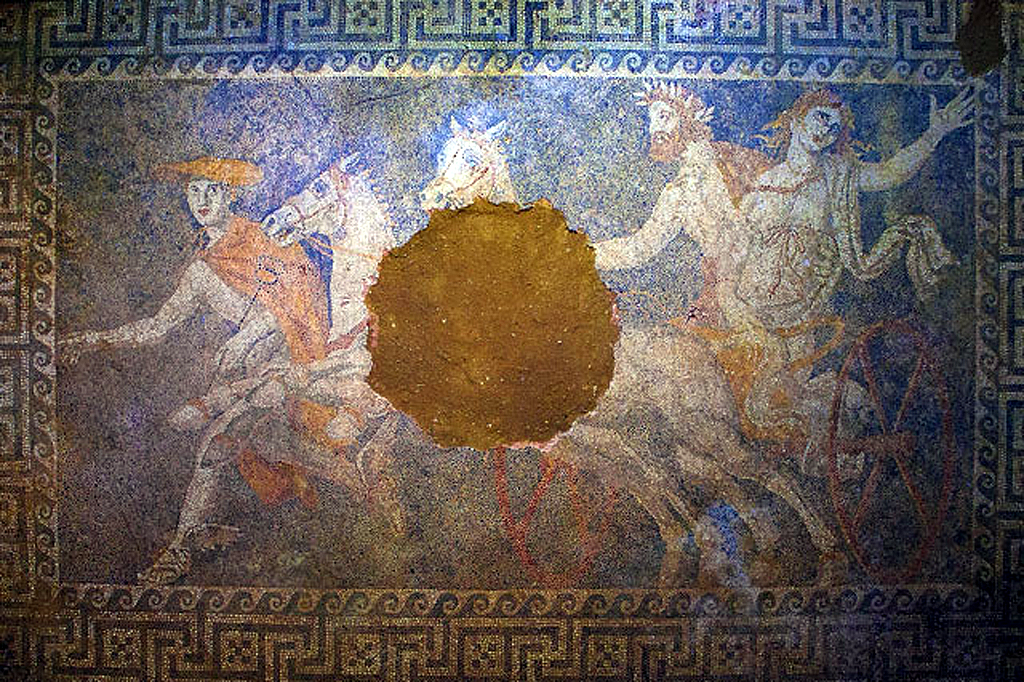It looks like you're using an Ad Blocker.
Please white-list or disable AboveTopSecret.com in your ad-blocking tool.
Thank you.
Some features of ATS will be disabled while you continue to use an ad-blocker.
10
share:
In the last half of 2014, archaeological news sources reported one discovery after another at the Amphipolis
(Kasta) Tomb in Greece. A list of these articles is available
here.
The succession of discoveries culminated on November 12th, when it was announced that a nearly intact skeleton had been located beneath the floor of the tomb's third chamber. There was some speculation about the bones possibly belonging to a general but beyond that, the world would have to wait for the results of the bones' analysis.
The Greek Ministry of Culture has now released the results and as the title indicates, they're quite a surprise... The remains belong not to an individual but to FIVE people!
April Holloway at Ancient Origins does a nice breakdown of the announcement (source is in Greek):
 Bones belonging to the 60-year-old female in the Amphipolis tomb. Credit: Ministry of Culture
Bones belonging to the 60-year-old female in the Amphipolis tomb. Credit: Ministry of Culture
The greatest number of bones were from the individual determined to be a female of approximately 60 years of age. The remains of the younger of the two men show evidence of unhealed (therefore, sustained at death) slashing injuries to the spine. The fragments of bones from the cremated individual were not enough to make a determination of the individual's age and sex but they're believed to be from an adult.
Will we ever know whose remains were buried in this ancient tomb? Are these relatives of Alexander the Great or possibly the family of one of his generals? Hopefully more information about the origins, lives, relationships and deaths of these people will be revealed by further analysis.
The succession of discoveries culminated on November 12th, when it was announced that a nearly intact skeleton had been located beneath the floor of the tomb's third chamber. There was some speculation about the bones possibly belonging to a general but beyond that, the world would have to wait for the results of the bones' analysis.
The Greek Ministry of Culture has now released the results and as the title indicates, they're quite a surprise... The remains belong not to an individual but to FIVE people!
April Holloway at Ancient Origins does a nice breakdown of the announcement (source is in Greek):

Person 1: Female, approximately 60 years
Persons 2 and 3: Two men, 35 to 45 years
Person 4: Newborn infant
Person 5: Cremated individual of unknown age and sex
The greatest number of bones were from the individual determined to be a female of approximately 60 years of age. The remains of the younger of the two men show evidence of unhealed (therefore, sustained at death) slashing injuries to the spine. The fragments of bones from the cremated individual were not enough to make a determination of the individual's age and sex but they're believed to be from an adult.
Will we ever know whose remains were buried in this ancient tomb? Are these relatives of Alexander the Great or possibly the family of one of his generals? Hopefully more information about the origins, lives, relationships and deaths of these people will be revealed by further analysis.
edit on 2015-1-19 by theantediluvian because: (no reason given)
a reply to: theantediluvian
Oh, that is really interesting. Some similar remains were found in the Hebrides, at South Uist:
Scottish Frankenstein Mummies

These were from the Bronze Age, around 3000 years ago. I haven't heard of this happening anywhere else, so it's fascinating to hear about this discovery.
Oh, that is really interesting. Some similar remains were found in the Hebrides, at South Uist:
Further examination of the remains led to another startling discovery. The male skeleton is actually a composite. Its torso, skull and neck, and lower jaw belong to three separate men. New DNA tests prove that the female skeleton is also a composite formed from a male skull, a female torso, and the arm of a third person, whose gender has yet to be determined. Carbon dating indicates that the skull of the female mummy is probably 50 to 200 years older than the torso.
Archaeologists have yet to agree why these remains were mummified and then mixed together. “The mixing of remains could have been designed to combine different ancestries or families into a single line of descent,” Parker Pearson explains. “At the time, land rights would have depended on ancestral claims, so perhaps having ancestors around ‘in the flesh’ was the prehistoric equivalent of a legal document.”
Scottish Frankenstein Mummies

These were from the Bronze Age, around 3000 years ago. I haven't heard of this happening anywhere else, so it's fascinating to hear about this discovery.
a reply to: beansidhe
It would be helpful if the Greek press release included pictures or diagrams of the remains in situ.
IIRC the Scottish skeletons were believed to have been in a bog for sometime so my guess is that whoever buried them was just fishing for bones in the bog and piecing them back together to the best of their ability.
It would be helpful if the Greek press release included pictures or diagrams of the remains in situ.
IIRC the Scottish skeletons were believed to have been in a bog for sometime so my guess is that whoever buried them was just fishing for bones in the bog and piecing them back together to the best of their ability.
a reply to: theantediluvian
Interesting find.
It must have been some sort of sacrifice to the change of the year/season in a ritual. But to put the sacrifice in a tomb, there must be more to it.
Could it be remnants left from a ritual that was the creation of one of their many gods?
To build a tomb for several body parts...
There was no BODY, right?
Interesting find.
It must have been some sort of sacrifice to the change of the year/season in a ritual. But to put the sacrifice in a tomb, there must be more to it.
Could it be remnants left from a ritual that was the creation of one of their many gods?
To build a tomb for several body parts...
There was no BODY, right?
TANN is reporting some additional details
about the bones:
So they think they've pieced together 157 out of about 550 bones found and some of the rest aren't human and are possible equine. I know that at least one other Greek tomb has been found that contained sacrificed horses. Also, it bears mention that the remains could actually be from more than five people.
Interestingly, the mosaic on the floor of the 2nd chamber is thought to be a depiction of the abduction of Persephone but maybe there's more to it than that.

The skeletal remains of the burial monument correspond to ca 550 bones, fractured and intact, a skull in a more or less good preservation state of which some bones making up the face are missing and an almost intact jawbone. No teeth were found apart from a decayed root of a right second biscupid, belonging to the lower jawbone and showing a gumboil. After carefully re-setting different fragments of dispersed bones 157 out of the 550 bones were systematically recorded in a database and an attempt has been made to attribute them to separate individuals. Furthermore, researchers identified animal bones some of which seem to belong to equine long bones. The animal bones will be studied by an expert in zooarchaeology. The minimum number of individuals identified so far corresponds to five persons; four burials and a cremation. The identified deceased of the burials are a woman (individual 1), two middle-aged men (individuals 2 and 3) and a newborn (individual 4).
So they think they've pieced together 157 out of about 550 bones found and some of the rest aren't human and are possible equine. I know that at least one other Greek tomb has been found that contained sacrificed horses. Also, it bears mention that the remains could actually be from more than five people.
Interestingly, the mosaic on the floor of the 2nd chamber is thought to be a depiction of the abduction of Persephone but maybe there's more to it than that.

edit on 2015-1-19 by theantediluvian because: (no reason given)
a reply to: Wifibrains
Unfortunately, all that has really been released to the public are the dimensions of the cist (eight square meters) and there's not much detail on how the bones were positioned within it. There's some indication from what I've been reading that the bones were later disturbed. Could it have been to make room for members of the same family who were later interred in the same tomb? It seems likely to me that these remains weren't interred at the same time since one of them was cremated.
Unfortunately, all that has really been released to the public are the dimensions of the cist (eight square meters) and there's not much detail on how the bones were positioned within it. There's some indication from what I've been reading that the bones were later disturbed. Could it have been to make room for members of the same family who were later interred in the same tomb? It seems likely to me that these remains weren't interred at the same time since one of them was cremated.
edit on 2015-1-19 by theantediluvian because: (no reason given)
new topics
-
This should be plastered all over the airwaves
Mainstream News: 30 minutes ago -
Oh, Good Gosh. “Kremlin Warns Stay Away from Greenland.”
World War Three: 2 hours ago -
Archbisop Vigano Warns of Deep State and Deep Church
New World Order: 2 hours ago -
A Flash of Beauty: Bigfoot Revealed ( documentary )
Cryptozoology: 8 hours ago -
Fire insurance in LA withdrawn months ago
General Conspiracies: 10 hours ago
top topics
-
Fire insurance in LA withdrawn months ago
General Conspiracies: 10 hours ago, 8 flags -
A Flash of Beauty: Bigfoot Revealed ( documentary )
Cryptozoology: 8 hours ago, 6 flags -
Oh, Good Gosh. “Kremlin Warns Stay Away from Greenland.”
World War Three: 2 hours ago, 5 flags -
Archbisop Vigano Warns of Deep State and Deep Church
New World Order: 2 hours ago, 3 flags -
This should be plastered all over the airwaves
Mainstream News: 30 minutes ago, 3 flags
active topics
-
To become president, Zelensky had to learn Ukrainian
Political Conspiracies • 33 • : Imhere -
This should be plastered all over the airwaves
Mainstream News • 3 • : KrustyKrab -
Oh, Good Gosh. “Kremlin Warns Stay Away from Greenland.”
World War Three • 9 • : Flyingclaydisk -
Los Angeles brush fires latest: 2 blazes threaten structures, prompt evacuations
Mainstream News • 302 • : KrustyKrab -
Trump says ownership of Greenland 'is an absolute necessity'
Other Current Events • 95 • : Lazy88 -
Fire insurance in LA withdrawn months ago
General Conspiracies • 26 • : sapien1982 -
The Truth about Migrant Crime in Britain.
Social Issues and Civil Unrest • 45 • : covent -
Judge rules president-elect Donald Trump must be sentenced in 'hush money' trial
US Political Madness • 87 • : tkwaz -
A Flash of Beauty: Bigfoot Revealed ( documentary )
Cryptozoology • 4 • : CosmicFocus -
Archbisop Vigano Warns of Deep State and Deep Church
New World Order • 0 • : FlyersFan
10
